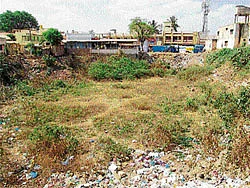One look at the Gajagundla tank in the heart of the town and a person can doubt whether it ever was a popular source of water.

The tank is covered in weeds, thorny shrubs and mostly garbage dumped by the citizens.A couple of decades ago, the Gajagundla tank was a popular haunt all over the taluk for clear, pure water.
The legend goes that the water tank was a temple tank constructed about 200 years ago by Jamedar Hridaya Ram Singh, a native of Bundelkhand in Madhya Pradesh and a staunch devotee of Lord Rama. Intending to solve the problem of water shortage in the region, Singh is said to have constructed the tank next to the Kodanda Ramaswami and Marikamba temple.
The tank proved a success as rain water from almost all over Malur town was collected in the hollow. Recently, a channel was constructed so that extra water from the fountain near bus stand flowed into the tank. The fountain had not only become the major source of water for the Gajagundla tank, but also provided continuous supply of water to the tank even in summer. Better still, people could consume the water with no fear of epidemics.
A Gurkha- a guard- had been appointed to watch the Gajagundla tank. He ensured only people who took water for domestic use or consumption had access to the water, say senior residents of the town. In addition, the tank, which had stairs in all directions, leading to the water, had an entrance from only one direction.
People who spent the night at the temple listening to Harikathe- tales from the legends- used the waters of the Gajagundla tank to wash their hands, feet and faces in the morning. There was, however, still a rule that people had to carry the water up, out of the tank, to use it for their personal needs. This ensured the water remained free from contamination.
Whenever the Gajagundla tank was filled with water, the coracle fest was organised at the Kodanda Ramaswami temple with grandeur. Devotees who attended the festivals at the temple of Marikamba, the local goddess of Malur, bathed in the waters of the Gajagundla tank before coming to the temple. Even the offerings during the prayers were made using the water from the tank.
Today, the condition of the tank is far from satisfactory. In the last few decades, the rainwater canals that supplied water to the tank have been closed. With the Gajagundla tank drying up, the citizens and local organisations too have turned a cold shoulder to its condition.
Also, since there has been no proper management of the tank, weeds and thorny bushes have grown on the tank bed. Worse, the tank has converted into a garbage disposal ground.
Senior residents of Malur can only reminisce the programmes organised on the banks of the tank during the coracle fest with a great sense of loss. M R Venkatappa, a local senior leader hopes the Town Municipal Council and various organisations take steps to prevent the total destruction of the tank.
“They need to work for the rejuvenation of the water tank. The water canals need to be developed so that the flow of water into the tank is renewed. This can also easily solve a major part of the drinking water problem of the town,” he explained.
